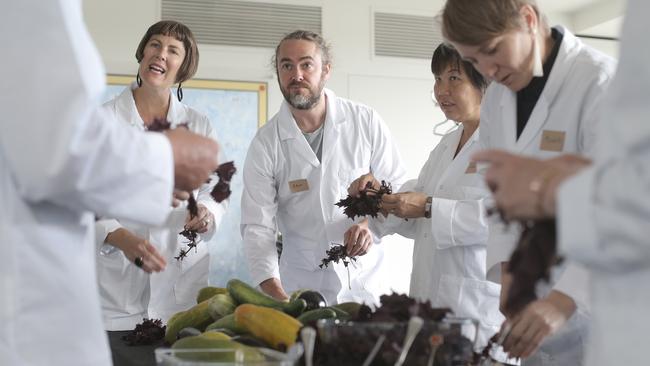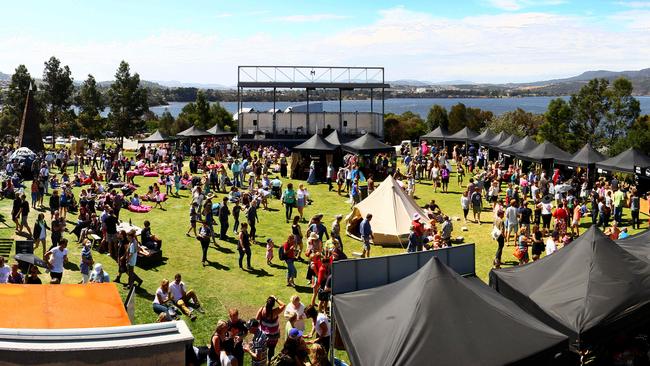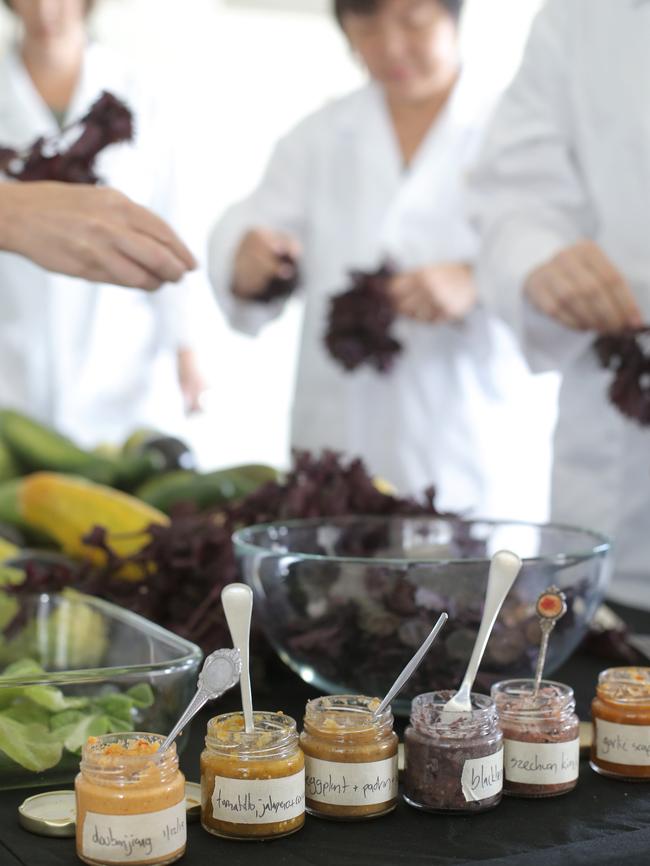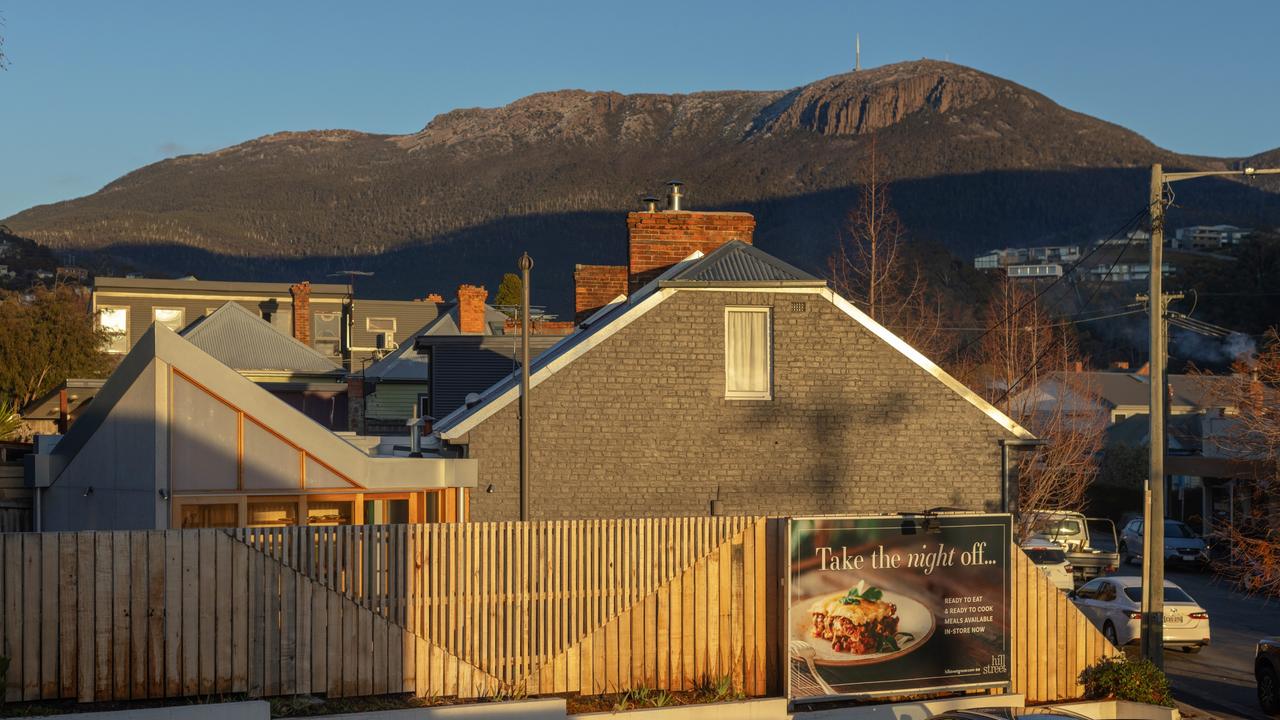TasWeekend travel: Fermented foods full of flavour
MONA’S weekly fermentation labs are all about creating unique tastes, with the health benefits an added bonus, writes SALLY GLAETZER.

Travel
Don't miss out on the headlines from Travel. Followed categories will be added to My News.
MONA seems like its own little universe when I arrive for a Sunday masterclass on the art of fruit and vegetable fermentation. The sprawling museum complex seems to have its own microclimate, hotter and gustier than other parts of Hobart. Waves of cool young things waltz dreamily up the driveway past the vineyards, most likely unaware the Moorilla winery existed on site well before the famous museum.
In what could be mistaken for a work of staged surrealism, a herd of large bright pink beanbags hurtles across the driveway, carried by a sudden, isolated gust of wind that barely ruffles a hipster beard.
On the Mona lawns, the weekly summer market, MoMa, is getting under way. Jewellery-makers show their wares alongside boutique local skincare brands, glittery face-painters, clothing designers and food sellers. Most stallholders have incorporated this year’s market theme, fermentation, into their goods in some way. The nail-polish artists are basing their designs on microscopic images of cells found in wine, beer and tequila; handmade soaps are made from yoghurt and beer; and a scarf designer is even using “fermented fabric”.

Adam James, of Hobart’s acclaimed Tricycle cafe, is running today’s fermentation lab. Half a dozen other students and I join James and MoMa food curator Jo Cook in a downstairs room of the Ether building, which opens onto the Mona lawns. We don white lab coats, scrub our hands with some hardcore soap and get down to business.
First, for inspiration, we get to try some of James’ fermented hot condiments such as kimchi, salsa picante and various other combinations of fruit and vegetables, salt and chilli. It sounds like his home kitchen and backyard fridge have become a fermentation laboratory as he strives to create unique flavours for Tricycle and his off-shoot catering business Rough Rice.
It was a workshop with sauerkraut guru Sandor Katz that first fuelled James’ interest in fermented food.
“I suppose my interest started with dabbling in sauerkraut and kimchi,” he says.
“Then I started getting into hot sauces because I’ve always loved sambal and things like that. By fermenting them they get a depth of flavour you can’t get from using vinegar and sugar.
“Now it’s become a very expensive hobby,” James adds, describing the huge custom crock-pots he has just invested in. He recently returned from Japan, where he spent two weeks delving into centuries-old fermentation processes and generally eating and drinking his way through Tokyo and Kyoto.
While the whole world seems to be talking about the health benefits of eating food that is “alive with good bacteria”, the attraction of fermented food for James is the taste factor.
“First and foremost for me is the flavour, but the added bonus is the health benefits,” he says.

In this hour-long class we are making shibazuke, which is fermented eggplant, cucumber, ginger and red shiso, an Asian herb similar to mint that James tells us is easy to grow in Tasmania. We start chopping a picturesque array of large, knobbly cucumbers (picked from the gardens at the Agrarian Kitchen) and various types of eggplant.
The chopped fruits, which are often wrongly considered vegetables, are put into bowls and sprinkled with salt. We then transfer them to a large mixing tub along with finely chopped ginger and the red shiso, which we salted and shredded.
There is something extremely relaxing about chopping on a Sunday morning with the sounds of live music and a happy crowd wafting in through the open doors. Before we know it, the hour is almost up.
The final step involves getting our hands messy, mixing and squeezing the mixture then packing it into large glass jars. We add airlock lids to the jars and our communal condiment is ready to take home where the fermentation process will start.
Our takeaway goodie bags include a set of smaller jars, into which we will transfer the shibazuke once it is nicely fermented and ready to eat.
The Fermentation Lab is hosted by a different instructor each week and at the end of the MoMa season, on Sunday, March 27, students are invited back to Mona for a cocktail party where they can swap their fermented goods.
James instructs us to keep our jars tucked away for at least three days, so at the time of writing I am unable to report on the results of our efforts. I feel an hour is far too short a time to really grasp all there is to know about fermented food, but it is a good starting point for anyone interested in adding a touch of umami to their diet.
Make a note
WHEN: MoMa Fermentation Labs run each Sunday at Mona from 11am to noon.
PRICE: $100, which includes a large airlock jar and several condiment jars, plus a recipe and instruction sheet.
TICKETS: Must be pre-purchased at momahobart.net.au


